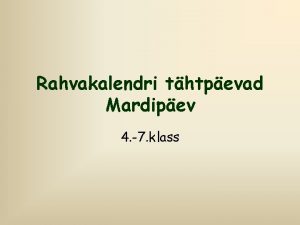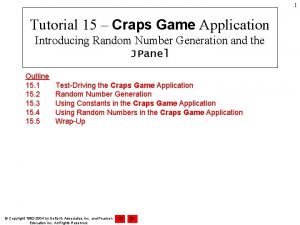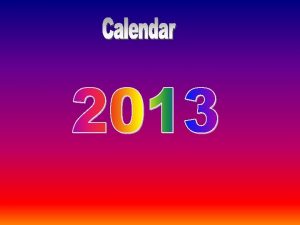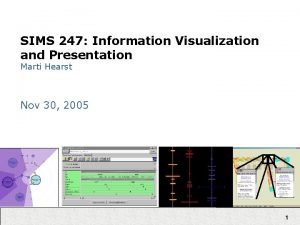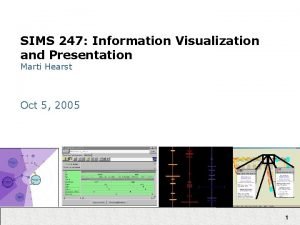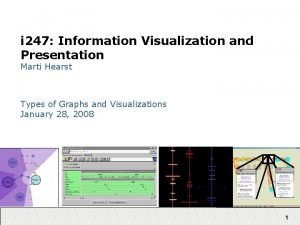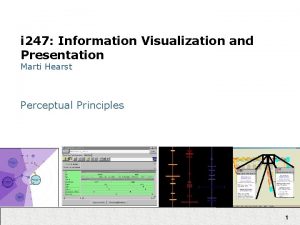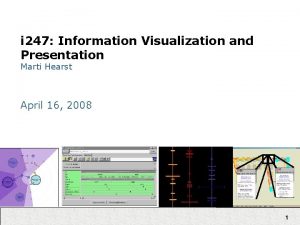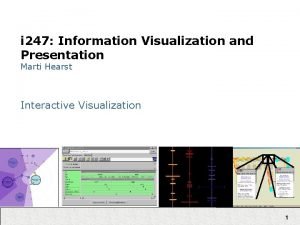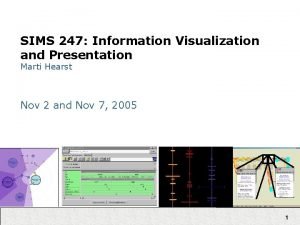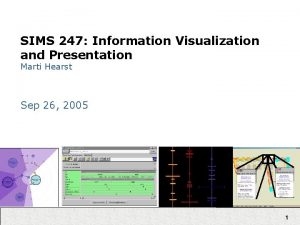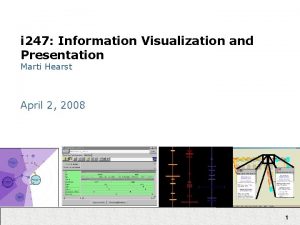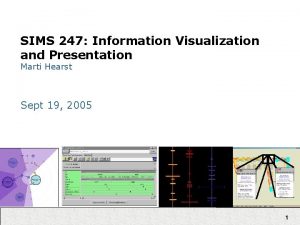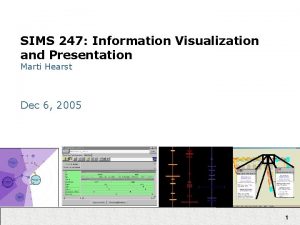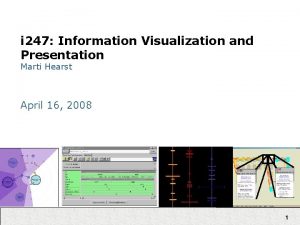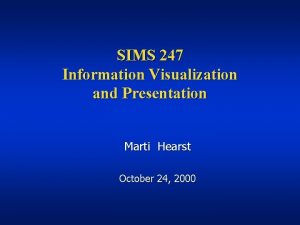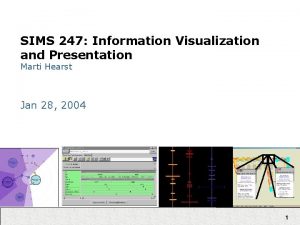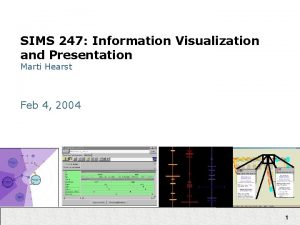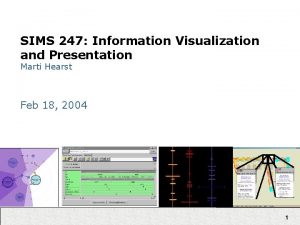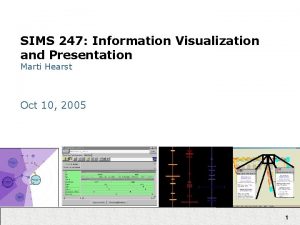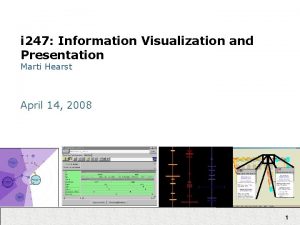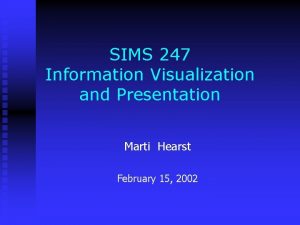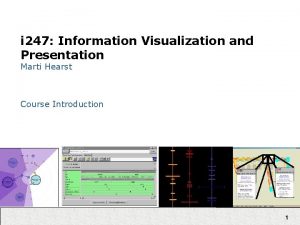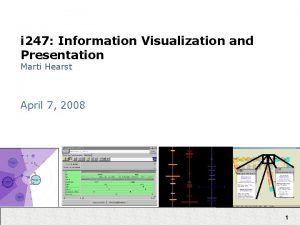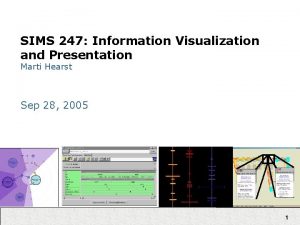i 247 Information Visualization and Presentation Marti Hearst






























- Slides: 30

i 247: Information Visualization and Presentation Marti Hearst Data Types and Graph Types 1

Outline • • The Roles and Stages of Visualization (briefly) Data Models and Types of Data Which Kinds of Graphs for Which Types of Data? Class Exercise 2

The Roles and Stages of Visualization 3

What Visualization Can Do (Ware) • • Allows comprehension of huge amounts of data. Allows perception of emergent properties Enables problems with the data to stand out Facilitates understanding at both large and small scales; patterns linking local features • Facilitates hypothesis formation. 4

What Visualization Can Do (Tufte ’ 83) • • • Show the data Induce to viewer to think about the data Avoid distorting what the data have to say Present many numbers in a small space Make large data sets coherent Encourage the eye to compare different pieces of data • Reveal the data at several levels of detail, from overview to fine structure • Serve a clear purpose: – Description, exploration, tabulation, or decoration • Be closely integrated with the statistical and verbal descriptions of a data set. 5

Stages of Visualization (Ware) • Collection and storage of data • Preprocessing to transform data into something understandable • Hardware and graphics algorithms for producing an image on the screen • Human perceptual and cognitive system. • (I think he’s missing a stage … Design of the visualization. ) 6

Put it Into Questions • • What are our goals? What questions do we want to answer? What kind of data might we collect? How might we convey the information associated with this data? 7

Visualization Components • Human Abilities • • Design Principles Visual perception • Visual display • Cognition • Interaction • Motor skills Imply Inform design • Frameworks • Data types • Tasks Constrain design • Techniques • Graphs & plots • Maps • Trees & Networks • Volumes & Vectors • … • Design Process • Iterative design • Design studies • Evaluation From Melanie Tory 8

Data Models and Types of Data 9

Basic Elements of a Data Model • A data model represents some aspect of the world • Data models consist of these basic elements: – objects – values (also called attributes) – relations 10 Adapted from Stone & Zellweger

Basic Elements: Objects • Objects are items of interest – people, plants, cars, films, etc… • Objects allow you to define and reason about a domain – ecosystem: ponds, streams, woodlands, mountains, plants, animals, etc. 11 Adapted from Stone & Zellweger

Basic Elements: Values • Values (or attributes) are properties of objects • Two major types – quantitative – categorical • Appropriate visualizations often depend upon the type of the data values 12 Adapted from Stone & Zellweger

Basic Elements: Relations • Relations relate two or more objects – leaves are part of a plant – a department consists of employees • Ecosystem – connections between streams and lakes – predator/prey network of what eats what – … 13 Adapted from Stone & Zellweger

Types of Data (Ware) • Entities • Relationships • Attributes of Entities or Relationships – Nominal / Ordinal / Interval / Ratio (Stevens ’ 46) – Categorical / Integer / Real • Operations Considered as Data – – Mathematical Merging lists Transforming data, etc. Metadata (derived data) 14

Types of Data (Few) • Quantitative • Categorical (allows arithmetic operations) (group, identify & organize; no arithmetic) Nominal Ordinal Interval Hierarchical 15 Adapted from Stone & Zellweger

Types of Data • Quantitative (allows arithmetic operations) - 123, 29. 56, … • Categorical (group, identify & organize; no arithmetic) Nominal (name only, no ordering) • Direction: North, East, South, West Ordinal (ordered, not measurable) • First, second, third … • Hot, warm, cold Interval (starts out as quantitative, but is made categorical by subdividing into ordered ranges) • Time: Jan, Feb, Mar • 0 -999, 1000 -4999, 5000 -9999, 10000 -19999, … Hierarchical (successive inclusion) • Region: Continent > Country > State > City • Animal > Mammal > Horse 16 Adapted from Stone & Zellweger

Which Types of Graphs for Which Kinds of Data? 17

Quantitative Against Categorical From Few, "Quantitative vs. Categorical Data: A Difference Worth Knowing", DM Review 18 Magazine, April 2005

Quantitative against Quantitative From Few, "Quantitative vs. Categorical Data: A Difference Worth Knowing", DM Review 19 Magazine, April 2005

Questions to ask when creating a graph • Is a graph needed? – Yes, if illustrating relationships among measurements • What information is being conveyed? – What is most important? – Start by writing a title 20

Questions to ask when creating a graph • What data is needed to answer specific questions? – Overview? Relationships? – Grice’s maxims • combine relevant information together • don’t show extraneous information • Who is your audience? 21

What Format to Use? • Bertin has a notion of efficiency • Tufte says “show the data” • Let’s start with familiar graph types – – line graphs bar charts scatter plots layer graphs • When to use each? 22

Anatomy of a Graph (Kosslyn 89) • Framework – sets the stage – kinds of measurements, scale, . . . • Content – marks – point symbols, lines, areas, bars, … • Labels – title, axes, tic marks, . . . 23

When to use which type? • Line graph – x-axis requires quantitative variable – differences among contiguous values – familiar/conventional ordering among ordinals • Bar graph – comparison of relative point values • Scatter plot – convey overall impression of relationship between two variables 24

What to put on the x axis? • Independent vs. Dependent variables – we often measure one quantitative variable against another – the value of one changes in relation to the other – the dependent variable changes relative to the independent one – the independent variable acts as a “measuring stick” • Independent usually goes on the x (horizontal) axis 25

Independent vs. Dependent • Independent vs. Dependent variables – heat in degrees against time – sales against season – tax revenue against city • What happens when there is more than one independent variable? – Choose one for the x axis, and another as a variation in the mark (color, shape) 26

Few on How to Show Information • The best way to show a single value? – Use a textual representation. – Why? • How to draw attention to a number? 27

Few on How to Show Information • What are tables good for? – Data lookup – Hierarchical relationships 28

Class Exercise 29

How to Combine Data Types? • Class Exercise: – Using data about autos from the 70’s – Each person get a column of data • First, identify the data type • Then, stand up • Then, repeat the following several times: – Walk up to someone else. If they have a different column than you do, discuss whether and how you should plot your two columns. » If yes, what question are you answering? » If no, why not? • Then, repeat this, but with groups of three people. 30
 Marti a. hearst
Marti a. hearst Marti hearst
Marti hearst Mardipäeva kombed
Mardipäeva kombed Hearst tower structure analysis
Hearst tower structure analysis William randolph hearst
William randolph hearst Hearst patterns python
Hearst patterns python Hearst museum
Hearst museum Information visualization ppt
Information visualization ppt Introduction to information visualization
Introduction to information visualization Information visualization
Information visualization Money 247
Money 247 Usf eap
Usf eap 562-247-8422
562-247-8422 562-247-8422
562-247-8422 247 templates
247 templates 40 cfr part 247
40 cfr part 247 247 craps
247 craps Uml module
Uml module 825 en yakın onluğa yuvarlama
825 en yakın onluğa yuvarlama Yoursafezone 247
Yoursafezone 247 Module 1. stl sequential containers
Module 1. stl sequential containers Art 243 kpk
Art 243 kpk Econ 247
Econ 247 Jose marti ubc
Jose marti ubc Iasmeninimas
Iasmeninimas Luni marti miercuri joi sau vineri
Luni marti miercuri joi sau vineri Happy end kurt marti inhaltsangabe
Happy end kurt marti inhaltsangabe Gary marti
Gary marti Marti reinfeld
Marti reinfeld Tarp pilku debesu pagrindiniai veikejai
Tarp pilku debesu pagrindiniai veikejai Escola jaume balmes sant martí sarroca
Escola jaume balmes sant martí sarroca


